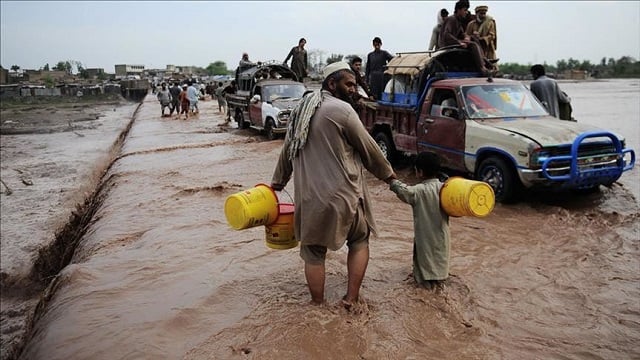Climate change is a global phenomenon that poses threats worldwide. Pakistan is among the top five countries susceptible to climate change, making it a serious concern. In recent decades, natural disasters such as floods, droughts, heavy rainfall, and heat waves have become more common in Pakistan due to climate change. The melting of glaciers in the Hindukush Karakoram and Himalayas (HKH) has affected several significant rivers in Pakistan.
The catastrophic floods of 2022 directly affected over 33 million people in Pakistan, causing loss of lives, infrastructure damage, and home relocation. Approximately 8 million people have been forced to migrate as Internally Displaced People (IDPs) due to climate change. This article aims to analyze the complex interconnections between climate-induced migrations in Pakistan and their cascading effects on the local and global economies. According to the Global Climate Risk Index, there were 9,989 fatalities caused by 152 catastrophic weather events in Pakistan between 1999 and 2018.
Climate-induced migration is another significant climate consequence neglected and understudied in Pakistan. In the last decade, the number of climate migrants who have relocated to metropolitan areas due to natural disasters has increased. By the year 2050, it is estimated that climate-related calamities will cause approximately 2 million individuals in Pakistan to become climate migrants.
Climate Change and Extreme Events
Many countries worldwide face climate change’s negative consequences, and Pakistan is no exception. Due to its arid nature and limited resources, Pakistan is particularly vulnerable to climate-induced risks. The country risks experiencing various natural disasters, including floods, droughts, and heatwaves. Unfortunately, the frequency and intensity of these occurrences have increased in recent decades. In 2010 and 2022, unprecedented rainfall triggered catastrophic floods in Pakistan. The Global Climate Change Vulnerability Index (CCVI) developed by Maplecroft classified Pakistan as the 29th most vulnerable country from 2009 to 2010. However, this ranking has since increased, with Pakistan being listed as the 16th most vulnerable country in 2010-2011.
Why is Pakistan vulnerable to climate extremes?
Pakistan is a region that is vulnerable to various weather systems. The heatwave in March 2022 is an example of extreme temperatures and drought caused by deforestation, air pollution, and carbon emissions. At the same time, monsoon rains from the east and southeast during summer and westerly disturbances from the Mediterranean Sea during winter can cause flooding. Due to its geographic location, dependence on fossil fuels, and deforestation, Pakistan is particularly susceptible to the impacts of climate change, including rising sea levels and an increase in extreme weather events such as floods, droughts, and heatwaves.
Pakistan’s energy sector relies heavily on fossil fuels, producing approximately 76% of total CO2 emissions. Deforestation is another issue, reducing the tree population’s ability to sequester atmospheric carbon dioxide. Imagine Pakistan as a beautiful garden with a grumpy neighbour named “Climate Change,” which makes it vulnerable to extreme weather.
Historically, Pakistan has experienced numerous natural hazards, including floods, earthquakes, droughts, and storms. Since its independence in 1947, Pakistan has witnessed over 29 floods, with the first super flood hitting the nation in 1950. The return period of these floods has shrunk, with floods almost every year since 2010. The 2022 flood was the most massive of all, impacting around 33 million people and causing damage of 15.2 billion USD.
Drought is also among the climate-induced disasters that affect Pakistan. The worst drought was recorded between 1998 and 2002, affecting approximately 1.2 million people in 26 districts of Balochistan province and causing around 60% of the population in Sindh province to migrate to other areas. Additional dams and reservoirs must be built to store rainwater for use during periods of drought.
Climate Change and Migrations
It is not a new phenomenon that human mobility is linked to environmental forces; nonetheless, global climate change is causing increased migrations and displacements within and across borders. There are instances when the effects of climate change are pretty quick to manifest. In the year 2022, for example, the drought caused more than one million Somalis to be forced to relocate, most of whom were within Somalia. Between 2019 and 2022, the global community documented more than 20 million displaced people due to natural disasters. However, most of these individuals did not remain displaced for an extended period; by the end of each year, fewer than 9 million people remained internally displaced. Most of the displacement that occurs because of natural disasters is temporary. Still, migration due to slow-onset climate change may be more permanent and significant. One recent example was the 2022 floods in Pakistan, which displaced an estimated 8 million people. Thousands of Pakistani people tried their luck to get into European soil without proper documentation due to various reasons.
It was a movement that made headlines when a boat carrying roughly 350 Pakistanis and hundreds of other migrants crashed off the coast of Greece. It is important to remember that the concept of climate change still does not qualify as a basis for international protection, as no international legal category is appropriate for climate refugees or migrants. The Refugee Convention of 1951 stipulates that to be considered a refugee, an individual must have fled persecution related to one of the following five grounds: race, religion, nationality, political ideology, or membership in a particular social group. Environmental elements are not mentioned in the convention.
What Solutions do G20 countries provide to deal with climate migrations?
The impact of environmental factors on migration has long been a significant concern worldwide. However, due to climate change, this impact has become even more complicated and substantial in recent years. Natural disasters are now forcing millions of people to leave their homes, and most of those displaced individuals are seeking refuge within their own countries. Unfortunately, the current international humanitarian frameworks do not provide adequate tools for environmental migrants who cross international borders.
Environmental migration is now a hot topic, and countries like the United States have both a chance and a responsibility to advocate for global solutions. If politicians want to help those most affected by environmental shocks, they must consider their specific vulnerabilities, skill sets, and life situations. Similarly, the G20 countries, which have significant economic and technological power, have the potential to play a pivotal role in addressing climate migration. They can do this by taking the following steps:
1. To minimise displacement, Invest in climate-resilient infrastructure in vulnerable countries, such as drought-resistant crops and early warning systems.
2. Supporting a just transition for displaced communities by creating green jobs and livelihoods in host regions.
3. Establishing legal frameworks to protect the rights of climate refugees and ensure safe and dignified resettlement.
4. Setting an example in aggressively reducing emissions to mitigate climate change and prevent further displacement in the long run.
By taking action and implementing these comprehensive solutions, the G20 countries can provide communities struggling with the terrible reality of climate migration with a glimmer of hope and a concrete route forward.














